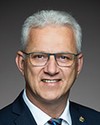Mr. Speaker, I am pleased to correct any misunderstandings from some members of the House may have regarding benefits for veterans, including the pension for life for members of the Canadian Armed Forces who have been discharged for medical reasons.
Canadians are proud of our brave veterans and we are proud of the investments we have made to improve the benefits available to these veterans. We have done a lot. We promised to restore a monthly pension, and this pension takes effect today, on April 1. The pension for life replaces the previous types of financial support and takes a holistic approach focused on the well-being of veterans who experience a service-related illness or injury.
The first benefit is the pain and suffering compensation, which replaces the lump-sum disability award with a tax-free benefit of $1,150 per month for life. Veterans can also choose between a monthly benefit or a lump sum benefit. Previously, a lump sum payment was the only choice. In addition, we replaced the career impact allowance, a taxable benefit, with the pain and suffering compensation, which is tax free.
These allowances are for veterans with a permanent severe impairment resulting from service. We listened to them and did something about it, unlike the Conservatives who cut services for veterans for 10 years.
We have the income replacement benefit, which provides the equivalent of 90% of a veteran's income during the rehabilitation period. This benefit is also available for survivors and orphans.
Before we launched the pension for life, on April 1, 2018, we introduced a series of new and improved initiatives to better support veterans and their families, including the caregiver recognition benefit, a tax free monthly benefit of $1,000 paid directly to persons who provide informal care to a veteran who receives a disability award or a pain and suffering compensation.
However, we understand that financial security is just one aspect of well-being. Transitioning from the army to civilian life is a big deal, especially for someone who is demobilized for medical reasons. The suite of programs and services for veterans and their families also seeks to help them transition successfully. Beyond the veterans emergency fund, the programs support physical, professional, and mental rehabilitation and reintegration into a new community.
One important part of a successful transition is finding a new career or new purpose. We also focused our efforts on new careers. Qualified career counsellors are available to help veterans find the career that suits them best. The veteran's partner, spouse or survivor is also eligible for training and career coaching, support for career development, and, in some cases, placement in a position directly related to the veteran. If education or training is needed to help them find a new job, the education and training benefit offers up to $40,000 for veterans with six years of service and up to $80,000 for veterans with 12 years of service.
Another important part of a successful transition is finding a place in a new community. By expanding the veteran family program to include medically released veterans and their families, we are helping them find the programs they need while maintaining precious ties to their military community.
We are proud of the improvements we have made to help veterans successfully transition to civilian life after serving in the military.





